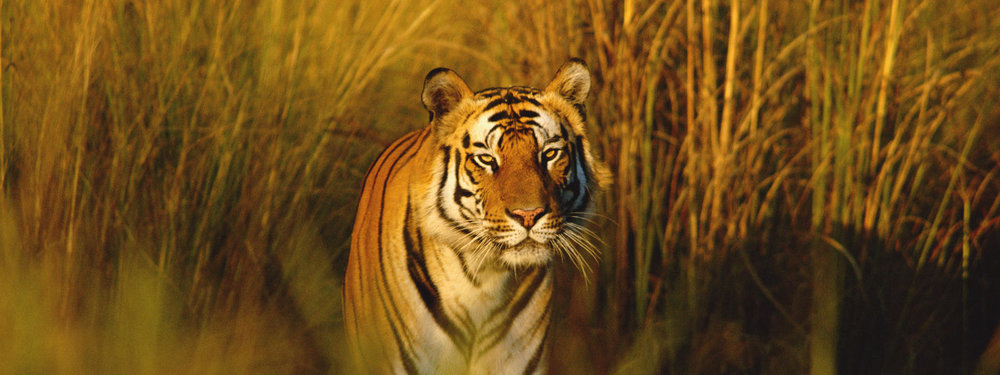Traces of extinction

TEHRAN — Tigers used to occur across Asia as far west as Turkey. Isolated populations of tigers developed into eight different subspecies.
Three generations ago, the tiger ranged from the Caucasus and Turkey through the southern Caspian region of northern Iran to the forested areas along the Oxus River in Afghanistan, the shores of the Aral Sea and Lake Balkhash, Sinkiang, the Altai and the Irtish Basin. Since the beginning of 20th century numbers have sharply declined, usually through conflict with humans.
Caspian Tiger (Panthera tigris virgate) experienced the same decline and by the 1950s had become extinct. This specific subspecies as an intermediate subspecies between the Siberian and Indian Tigers, once ranged throughout the lowland forests and extensive reed-beds in the Caspian provinces. Although Iran lost this specific subspecies forever, India now has 70 percent of world’s tiger population because of unique experiments in wildlife conservation plans.
Iran lost tigers forever
By the 1950s three of the tiger subspecies (Caspian, Bali and Javan) have become extinct. There is absolutely no alive Caspian tiger in the world, not just in the wild and not even in Zoos around the world. Extinction of Caspian tiger is a great regret especially knowing that tigers can breed well in captivity and they are unlikely to become extinct.
Some experts say the last Caspian tiger were shot in Golestan National Park in 1953, although there was a reliable report of a sighting in the Golestan area in 1958. Biologists from the Department of the environment devoted several years in the early 1970s to searching for Caspian tiger in the uninhabited areas of the Caspian forests, but no trace or evidence was found. It is believed that tigers disappeared from Afghanistan at about the same time as it did from Iran, if not earlier.
Tehran Zoo has two subspecies of Tigers: The largest subspecies, the Amur or Siberian tiger once ranged throughout the forest areas of China and Korea, north to the forested edges of Siberia. And the Bengal tiger which is found primarily in India with smaller populations in Bangladesh, Nepal, Bhutan, China and Myanmar. It is the most numerous of all tiger subspecies with more than 2,500 left in the wild.
A valuable resource for investigating the genetic diversity
The tiger (Panthera tigris) is the world’s largest field species and is predicted to soon become extinct if effective conservation measures are not deployed.
The preservation of wild tiger populations, currently estimated to total less than 4000 individuals, is now a major goal of animal conservationists. Three years ago, Yun Sung Cho and his colleagues presented the first tiger genome sequence assembly, utilizing the DNA of a nine-year old tiger from Everland Zoo, Korea, and sequence four additional Panthera genomes in order to better understand the predatory adaptations and evolution of big cats.
The team identified 1,376 big-cat specific amino acids changes indicative of a carnivorous diet, through a comparative analysis of genomes including tiger, human, dog and mouse, and provided evidence for the rapid evolution of genes involved in muscle contraction and the actin cytoskeleton.
The team also identified two candidate genes that may have been important in the snow leopard’s adaptation to high altitudes and pinpointed a potential coat color gene in the white lion.
Dr. Jong Bhak from Personal Genomics Institute, Genome Research Foundation in Korea mentioned that “Tigers are apex predator; humans and tigers cannot co-exist in the same area and without protection, Amur tigers must be extinct by now.”
He went on to say that Korean tigers (which are slightly smaller and more yellowish) extincted in 1950-60s as Caspian tigers due to the same reasons such as excessive thoughtless hunting and farmland expansion and it is a grave mistake of us to eradicate them for many reasons.
Dr. Bhak also addressed the importance of conservation plans and said “Now people can more effectively preserve subspecies in zoos, for instance, in Korea, all the major TV broadcasting companies aired the tiger genome news at the prime news time.”
“This made almost everyone to know that Amur tigers are endangered and I am sure more funding can be produced indirectly,” he said, adding, “The most important thing for the tigers is that now the public is aware of their problem.”
The future of wildlife depends on scientific decisions
Tigers taught us good lessons, we lost Caspian tiger just because of breaking the laws of nature. We lost the chance of having Caspian Tigers not only in the wild but also in Zoos.
It would be relatively easy to breed captive tigers for reintroduction to the wild, but there is not enough suitable habitat left to release of captive-bred stock. By ignoring this simple factor, Iran conservationists experienced unsuccessful tiger captive breeding project which also caused many problems.
In 2010, two Siberian tigers sent from Russia to Iran in exchange for a pair of Persian leopards were set to be reintroduced in the wild to replace at the Miankaleh peninsula within the next five years. In December 2010, one of the captive Siberian tigers died because of contagious disease and it affected the whole project.
Female Amur Tiger after 5 years of Quarantine, now is alive and lives in good condition in Tehran Zoo.
This experience demonstrated that the future of wildlife lies just in careful management programs. There is absolutely no genetic information from Caspian tigers, so thinking about reintroduction of similar subspecies was a great mistake.
We must notice that the habitat of Caspian tiger is totally changed and tigers cannot adapt themselves even if they reintroduced to wild. Tigers had good lessons for us, not just in the past but also in recent years. We must know that when proper data are in place, yielding results started. So we must focus on saving other important wildlife species e.g. Asiatic cheetah or Persian leopards instead of regretting the loss of tigers.
